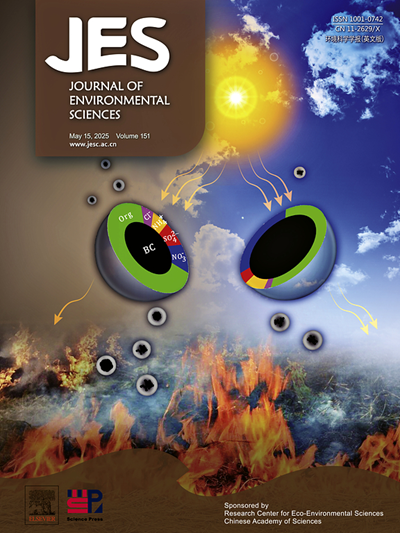Changes in the urban dew chemical composition in Northeast China from 2013 to 2023
IF 5.9
2区 环境科学与生态学
Q1 ENVIRONMENTAL SCIENCES
引用次数: 0
Abstract
The chemical composition of dew is closely related to the air quality. Since 2013, China has promulgated a series of laws and regulations focused on air pollution control, and remarkable results have been achieved over the past decade. As an indicator of near-surface air quality, the chemical composition of dew obviously changes. The dew quality was affected mainly by the local air quality. The mean dew pH was 6.3 ± 0.4 (n = 186) from 2013 to 2023, and the order of ions was SO42−(3180.7 ± 3592.0 µeq/L) > NH4+(2552.3 ± 2971.8 µeq/L) > Ca2+ (1006.2 ± 945.5 µeq/L) > NO3− (397.2 ± 511.0 µeq/L) > Cl−(152.3 ± 133.4 µeq/L) > K+(149.4 ± 191.6 µeq/L) > F−(133.0 ± 110.3 µeq/L) > Na+(123.8 ± 94.9 µeq/L) > Mg2+(83.3 ± 65.6 µeq/L). The dew quality deteriorated on hazy days. There were no haze events during the condensation period after 2020, which caused a significant reduction in the concentration of the main ions in the dew. Over the past decade, electrical conductivity (EC), total dissolved solids (TDS), PM2.5 and PM10, as well as major ions (SO42−, NO3−, NH4+, Ca2+, Cl−, Na+, F−, K+ and Mg2+) in dew, have all tended to decrease. The annual mean NO3− concentration in 2023 was 86.5 % lower than that in 2013, with values of 79.3 % for SO42−, 77.3 % for Ca2+, 76.7 % for NH4+, 74.6 % for K+, 65.4 % for Mg2+, 63.4 % for Na+, 61.7 % for Cl−, and 60.3 % for F−.
2013 - 2023年东北地区城市露珠化学成分变化
露水的化学成分与空气质量密切相关。自2013年以来,中国颁布了一系列以大气污染治理为重点的法律法规,十年来取得了显著成效。露珠作为近地表空气质量的指标,其化学成分变化明显。露珠质量主要受当地空气质量的影响。2013 - 2023年平均露水pH为6.3±0.4 (n = 186),离子数量级为SO42−(3180.7±3592.0µeq/L) >;NH4+(2552.3±2971.8µeq/L) >;Ca2+(1006.2±945.5µeq/L) >;NO3−(397.2±511.0µeq/L) >;Cl−(152.3±133.4µeq/L) >;K+(149.4±191.6µeq/L) >;F−(133.0±110.3µeq/L) >;Na+(123.8±94.9µeq/L) >;Mg2+(83.3±65.6µeq/L)。雾天露珠质量变差。2020年以后的凝结期没有出现雾霾事件,导致露珠中主要离子浓度显著降低。近十年来,露珠中的电导率(EC)、总溶解固形物(TDS)、PM2.5和PM10以及主要离子(SO42−、NO3−、NH4+、Ca2+、Cl−、Na+、F−、K+和Mg2+)均呈下降趋势。2023年NO3−年平均浓度较2013年下降86.5%,其中SO42−为79.3%,Ca2+为77.3%,NH4+为76.7%,K+为74.6%,Mg2+为65.4%,Na+为63.4%,Cl−为61.7%,F−为60.3%。
本文章由计算机程序翻译,如有差异,请以英文原文为准。
求助全文
约1分钟内获得全文
求助全文
来源期刊

Journal of Environmental Sciences-china
环境科学-环境科学
CiteScore
13.70
自引率
0.00%
发文量
6354
审稿时长
2.6 months
期刊介绍:
The Journal of Environmental Sciences is an international journal started in 1989. The journal is devoted to publish original, peer-reviewed research papers on main aspects of environmental sciences, such as environmental chemistry, environmental biology, ecology, geosciences and environmental physics. Appropriate subjects include basic and applied research on atmospheric, terrestrial and aquatic environments, pollution control and abatement technology, conservation of natural resources, environmental health and toxicology. Announcements of international environmental science meetings and other recent information are also included.
 求助内容:
求助内容: 应助结果提醒方式:
应助结果提醒方式:


